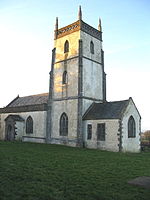Gurney Slade quarry

Gurney Slade quarry, grid reference ST626497 is a limestone quarry near Gurney Slade between Binegar and Holcombe, on the Mendip Hills, Somerset, England. Gurney Slade quarry exhibits pale to very dark grey Carboniferous Limestone overlain by red and purple-coloured Triassic breccias and marls with a small faulted block of overlying Lower Jurassic breccias forming an angular unconformity with the Carboniferous Limestone. There is abundant vertical sediment infilled fissures and joints (Neptunian Dykes). The rocks contain varying amounts of calcite mineralization, and there is common fossil material associated with the Carboniferous and Jurassic limestones. The limestone within the quarry dips to the south-east at around 30°.Work began at the quarry in the mid 18th century and grew after it was taken over by Francis Flower and Sons in 1928 producing stone for lime-burning. The quarry closed in 1947 and was reopened in 1951 by John Yeoman of Foster Yeoman. The next owner was City Sand and Gravel Co. and taken over by Morris & Perry (Gurney Slade) Ltd. who still operate the quarry. A Concrete plant was installed in 1963 and a coated macadam plant in 2001. The site is now capable of supplying up to 2 Million Tonnes Per Annum of Carboniferous Limestone aggregate. Francis Flower have a facility adjacent to the quarry which processes filler by-product from several Mendip quarries.
Excerpt from the Wikipedia article Gurney Slade quarry (License: CC BY-SA 3.0, Authors, Images).Gurney Slade quarry
Tape Lane, Mendip
Geographical coordinates (GPS) Address Nearby Places Show on map
Geographical coordinates (GPS)
| Latitude | Longitude |
|---|---|
| N 51.24524 ° | E -2.53719 ° |
Address
Tape Lane
Tape Lane
BA3 4TE Mendip
England, United Kingdom
Open on Google Maps








